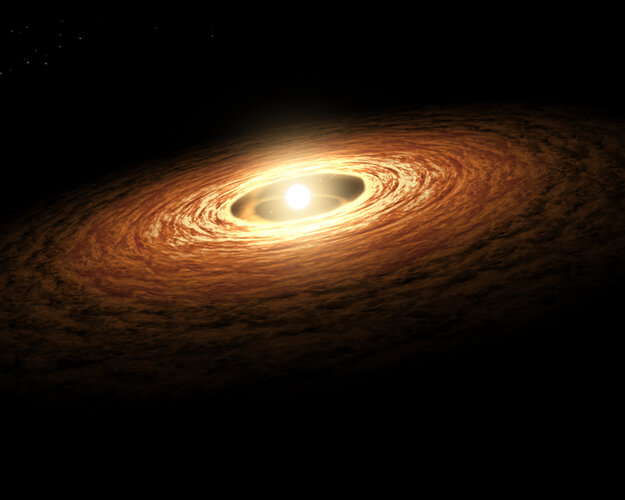
The spectrum revealed by Webb’s Mid-InfraRed Instrument (MIRI) shows the richest hydrocarbon chemistry seen to date in a protoplanetary disc, consisting of 13 carbon-bearing molecules up to benzene. This includes the first extrasolar detection of ethane (C2H6), the largest fully-saturated hydrocarbon [2] detected outside our Solar System. Since fully-saturated hydrocarbons are expected to form from more basic molecules, detecting them here gives researchers clues about the chemical environment. The team also successfully detected ethylene (C2H4), propyne (C3H4), and the methyl radical CH3, for the first time in a protoplanetary disc.
“These molecules have already been detected in our Solar System, for example in comets such as 67P/Churyumov–Gerasimenko and C/2014 Q2 (Lovejoy),” adds Aditya. “It is amazing that we can now see the dance of these molecules in the planetary cradles. It is a very different planet-forming environment from what we usually think of.”
The team indicates that these results have large implications for astrochemistry in the inner 0.1 AU and the planets forming there. “This is profoundly different from the composition we see in discs around solar-type stars, where oxygen bearing molecules dominate (like carbon dioxide and water),” added team member Inga Kamp, also of the University of Groningen. “This object establishes that these are a unique class of objects.”
“It’s incredible that we can detect and quantify the amount of molecules that we know well on Earth, such as benzene, in an object that is more than 600 light-years away,” added team member Agnés Perrin of Centre National de la Recherche Scientifique in France.
Next, the science team intend to expand their study to a larger sample of such discs around very low-mass stars to develop their understanding of how common such exotic carbon-rich terrestrial planet forming regions are. “The expansion of our study will also allow us to better understand how these molecules can form,” explained team member and PI of the MINDS programme, Thomas Henning, of the Max Planck Institute for Astronomy in Germany. “Several features in the Webb data are also still unidentified, so more spectroscopy is required to fully interpret our observations.”
This work also highlights the crucial need for scientists to collaborate across disciplines. The team notes that these results and the accompanying data can contribute towards other fields including theoretical physics, chemistry and astrochemistry, to interpret the spectra and to investigate new features in this wavelength range.
These results have been published in the journal Science.



